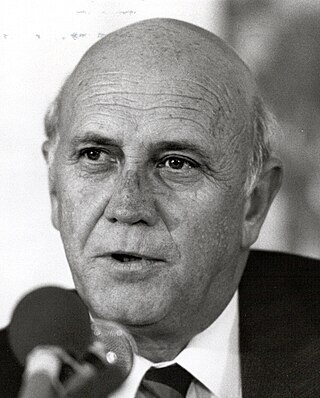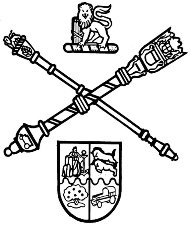
Frederik Willem de Klerk, OMG, DMS was a South African politician who served as state president of South Africa from 1989 to 1994 and as deputy president from 1994 to 1996. As South Africa's last head of state from the era of white-minority rule, he and his government dismantled the apartheid system and introduced universal suffrage. Ideologically a conservative and an economic liberal, he led the National Party (NP) from 1989 to 1997.

A Bantustan was a territory that the National Party administration of South Africa set aside for black inhabitants of South Africa and South West Africa, as part of its policy of apartheid. By extension, outside South Africa the term refers to regions that lack any real legitimacy, consisting often of several unconnected enclaves, or which have emerged from national or international gerrymandering.

Coloureds refers to members of multiracial ethnic communities in Southern Africa who may have ancestry from more than one of the various populations inhabiting the region, including African, European, and Asian. South Africa's Coloured people are regarded as having some of the most diverse genetic backgrounds. Because of the vast combination of genetics, different families and individuals within a family may have a variety of different physical features.

The Parliament of the Republic of South Africa is South Africa's legislature; under the present Constitution of South Africa, the bicameral Parliament comprises a National Assembly and a National Council of Provinces. The current twenty-seventh Parliament was first convened on 22 May 2019.

Pieter Willem Botha, was a South African politician. He served as the last prime minister of South Africa from 1978 to 1984 and the first executive state president of South Africa from 1984 to 1989.

The National Party, also known as the Nationalist Party, was a political party in South Africa founded in 1914 and disbanded in 1997, which was responsible for the implementation of apartheid rule. The party was an Afrikaner ethnic nationalist party, which initially promoted the interests of Afrikaners but later became a stalwart promoter and enactor of white supremacy and attempting to racially socially engineer South Africa through grand apartheid, for which it is best known. It first became the governing party of the country in 1924. It merged with its rival, the SAP, during the Great Depression, and a splinter faction became the official opposition during World War II and returned to power. With the National Party governing South Africa from 4 June 1948 until 9 May 1994, the country for the bulk of this time was only a de jure or partial democracy, as from 1958 onwards non-white people were barred from voting. In 1990 it began to style itself as simply a South African civic nationalist party, and after the fall of apartheid in 1994, attempted to become a moderate conservative one. The party's reputation was damaged irreparably by perpetrating apartheid and it rebranded itself in 1997 before eventually dissolving.

The Population Registration Act of 1950 required that each inhabitant of South Africa be classified and registered in accordance with their racial characteristics as part of the system of apartheid.
Elections in South Africa are held for the National Assembly, provincial legislatures and municipal councils. Elections follow a five-year cycle, with national and provincial elections held simultaneously and municipal elections held two years later. The electoral system is based on party-list proportional representation, which means that parties are represented in proportion to their electoral support. For municipal councils there is a mixed-member system in which wards elect individual councillors alongside those named from party lists.
The following lists events that happened during 1991 in South Africa.

Apartheid was a system of institutionalised racial segregation that existed in South Africa and South West Africa from 1948 to the early 1990s. Apartheid was characterised by an authoritarian political culture based on baasskap, which ensured that South Africa was dominated politically, socially, and economically through minoritarianism by the nation's dominant minority white population. According to this system of social stratification, white citizens had the highest status, followed by Indians and Coloureds, then Black Africans. The economic legacy and social effects of apartheid continue to the present day, particularly inequality.
Group Areas Act was the title of three acts of the Parliament of South Africa enacted under the apartheid government of South Africa. The acts assigned racial groups to different residential and business sections in urban areas in a system of urban apartheid. An effect of the law was to exclude people of color from living in the most developed areas, which were restricted to Whites. It required many people of color to commute large distances from their homes to be able to work. The law led to people of color being forcibly removed for living in the "wrong" areas. The majority that was people of color, were given much smaller areas to live in than the white minority who owned most of the country. Pass Laws required people of color to carry pass books and later "reference books", similar to passports, to enter the "white" parts of the country.

The Natives Land Act, 1913 was an Act of the Parliament of South Africa that was aimed at regulating the acquisition of land. According to the Encyclopædia Britannica: "The Natives’ Land Act of 1913 defined less than one-tenth of South Africa as Black “reserves” and prohibited any purchase or lease of land by Blacks outside the reserves. The law also restricted the terms of tenure under which Blacks could live on white-owned farms."

The Promotion of Bantu Self-Government Act, 1959 was an important piece of South African apartheid legislation that allowed for the transformation of traditional tribal lands into "fully fledged independent states Bantustans", which would supposedly provide for the right to self-determination of the country's black population. It also resulted in the abolition of parliamentary representation for black South Africans, an act furthered in 1970 with the passage of the Black Homeland Citizenship Act.
The system of racial segregation and oppression in South Africa known as apartheid was implemented and enforced by many acts and other laws. This legislation served to institutionalize racial discrimination and the dominance by white people over people of other races. While the bulk of this legislation was enacted after the election of the National Party government in 1948, it was preceded by discriminatory legislation enacted under earlier British and Afrikaner governments. Apartheid is distinguished from segregation in other countries by the systematic way in which it was formalized in law.

The House of Assembly was the lower house of the Parliament of South Africa from 1910 to 1981, the sole parliamentary chamber between 1981 and 1984, and latterly the white representative house of the Tricameral Parliament from 1984 to 1994, when it was replaced by the current National Assembly. Throughout its history, it was exclusively constituted of white members who were elected to office predominantly by white citizens, though until 1960 and 1970, respectively, some Black Africans and Coloureds in the Cape Province voted under a restricted form of suffrage.

The Population Registration Act Repeal Act, 1991 is an act of the Parliament of South Africa which repealed the Population Registration Act, 1950, ending the legal racial classification of South Africans which formed the basis of apartheid.

The Native Trust and Land Act, 1936 in South Africa passed a law that served as the reorganization of its agricultural structures. This followed the recommendations of the Beaumont Commission.
The Coloured vote constitutional crisis, also known as the Coloured vote case, was a constitutional crisis that occurred in the Union of South Africa during the 1950s as the result of an attempt by the Nationalist government to remove coloured voters in the Union's Cape Province from the common voters' rolls. It developed into a dispute between the judiciary and the other branches of government over the power of Parliament to amend an entrenched clause in the South Africa Act and the power of the Appellate Division to overturn the amendment as unconstitutional. The crisis ended when the government enlarged the Senate and altered its method of election, allowing the amendment to be successfully enacted.

The Tomlinson Report was a 1954 report released by the Commission for the Socioeconomic Development of the Bantu Areas, known as the Tomlinson Commission, that was commissioned by the South African government to study the economic viability of the native reserves. These reserves were intended to serve as the homelands for the black population. The report is named for Frederick R. Tomlinson, professor of agricultural economics at the University of Pretoria. Tomlinson chaired the ten-person commission, which was established in 1950. The Tomlinson Report found that the reserves were incapable of containing South Africa's black population without significant state investment. However, Hendrik Verwoerd, Minister of Native Affairs, rejected several recommendations in the report. While both Verwoerd and the Tomlinson Commission believed in "separate development" for the reserves, Verwoerd did not want to end economic interdependence between the reserves and industries in white-controlled areas. The government would go on to pass legislation to restrict the movement of blacks who lived in the reserves to white-controlled areas.
The All-African Convention conference took place from 15–18 December 1935. Notable figures who attended the delegation included Davidson Don Tengo Jabavu, Pixley ka Isaka Seme, JL Dube, Zacharias Richard Mahabane, Alfred Bitini Xuma, James Moroka and Thabo Edwin Mofutsanyana. The Convention consisted of representatives from across a broad political spectrum, including the African National Congress, the South African Communist Party, and the Industrial and Commercial Workers' Union. They convened at a community hall in Bloemfontein in response to three proposed bills by President J.B.M. Hertzog.











